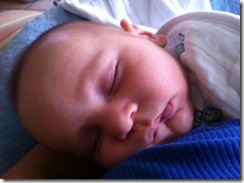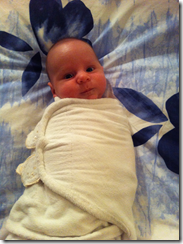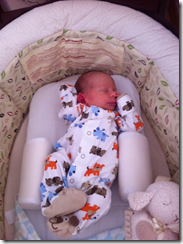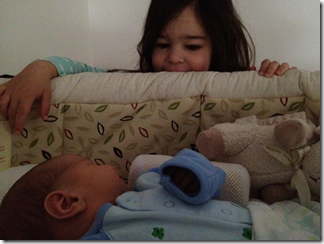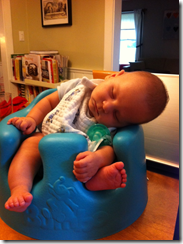How to sleep train your child
/This post is being written by request. I say this because every time I write a post that implies that I know something about parenting, I receive a mixed bag in terms of response, include a few angry people who believe that if my assertions regarding parenting run counter to their own beliefs, I must be attacking them.
I am not. I just think that I am right.
So today I write this post at the bequest of several readers who are curious about the methods my wife and I use to teach our children to sleep well.
It’s true that both of my children are outstanding sleepers. My three-year old daughter has been sleeping through the night ever since she was three months old and now routinely sleeps ten hours or more a night. My infant son began sleeping through the night (at least six hours at a time) at less than two months old and has topped out at eight hours several times, including last night.
It’s also true that we may simply be lucky. Perhaps our children, unlike their father, are genetically predisposed to sleep.
Genetics may play a role, but I don’t think they tell the whole story. When asked by parents how we managed to train our children to sleep through the night so effectively, I often list strategies that the parent has never heard of before or could never support. This leads me to believe that effective sleep training involves employing the correct strategies, and too many parents are either unaware of the strategies or are unwilling to use them.
These strategies are not our own. My wife read two books, The Happiest Baby on the Block and Healthy Sleep Habits, Happy Baby, and the following strategies (except for one) were pulled directly from these texts.
It’s not rocket science. It’s simply following the advice of experts.
Does this mean that these strategies will work for every child? Of course not. But I think they will work on 95% of children, and I think they will help all kids sleep better, if not well. If you have not yet tried to use these strategies on a consistent basis, then you really can’t discount them or complain when your child is not sleeping well.
The following are the four most important strategies that we use. There are others, of course, like a consistent bedtime routine and insisting that our children sleep in a darkened room (our son has blackout shades), but these seem obvious and not nearly as important as the following:
White noise: Both of our kids sleep with white noise. Clara is three years old and still uses it. In the beginning, white noise mimics the sound of the womb for infants and makes them feel at ease. As children get older, it serves as a signal that it’s time for sleep as well as a means by which outside noises (a barking dog, a car horn, thunder) are eliminated. If you are not using white noise with your infant or toddler, you are making a huge mistake. Even Elysha and I sleep with white noise now.
Swaddling: Both of our children were swaddled from day one. This means wrapping them up tighter than a burrito before putting them to bed. There are specially designed swaddle blankets with Velcro straps for people like me who have difficulty achieving an effective swaddle, but my wife can swaddle with just about any blanket. I have spoken to parents who think that swaddling is “mean” and “scary” for kids, but babies like to be swaddled. It mimics the confines of the womb and prevents them from waking themselves up with flailing arms and kicking feet. In fact, the only night that Charlie has slept less than six hours in the last month was the night his swaddle came undone.
Never ever let your children sleep in your bed: This is the rule most often violated by parents, and it is the most important. Children sleep best when they sleep alone in their own bed, and when they are old enough, in their own room. It is critical that children be taught to do this. As parents, it is our responsibility to teach our children to be effective sleepers, and when we place our own emotional needs ahead of this important job, we are hurting our kids. We made the mistake of allowing Clara to sleep in our bed once when she was feeling ill, and it was the worst night of sleep that all three of us have had in a long time.
Never again.
Both of our children slept in a cradle beside our bed when they were infants. Charlie is two months old so he is still there, though for the first night, he actually slept on the floor because the cradle was not ready. Anything but our bed.
-
When Clara was about four months old, she was moved into her own room. It was not easy. We liked having her in a cradle beside us. It was easier and made us happy to have her near us, but we knew that in order to teach her to be an effective sleeper, she needed to be moved. The longer we waited, the harder it would be. Listening to Clara cry for the first three nights that she was in her own bedroom was incredibly difficult, but by the fourth night, she was sleeping in her room, in her crib, without complaint. It must be done. She is a more rested and happier child because of it.
The self-rocking bassinet: This was not included in either of the books that Elysha read, but after three nights spent rocking Clara to sleep as an infant, I thought that there must be a machine to do this for me. There was. When I bought the self-rocking bassinet three years ago, it was the only one on the market and it was not exactly stylish (the mattress appears to have been imported from a Guantanamo Bay prison camp), but it did the job. Clara spent the first three months in a self rocking bassinet and Charlie is there now. Turn a knob and the bassinet rocks itself, allowing Elysha and I to sleep while the bassinet gently rocks the baby to sleep, switching off after 30 minutes. And when the baby begins to stir around 5:00 AM with the rising of the sun, it’s the self-rocking bassinet that puts him or her back to sleep for another hour or two. It’s indispensable.
It’s also true that Elysha and I are blessed with two children who have been easy to manage thus far. Perhaps they are both waiting for their teenage years to raise hell, but for now, both kids are more than we could have hoped for in terms of their behavior.
Are they genetically predisposed to these easy-going natures, and has this made sleep training much easier? Possibly.
But I also know that they are both well rested children, sleeping through the night and napping on regular schedules every day. If your child is challenging in terms of behavior, ask yourself:
Is your child getting enough uninterrupted sleep every day and night?
As teacher, I can assure you that a tired student is one who is more likely to misbehave during the day.
As a parent, I can tell you that a missed nap almost guarantees a deterioration in behavior later in the day.
Children who don’t sleep enough or spend portions of their night sleep beside parents and drop out of REM sleep every time someone tosses or turns in the bed have a more difficult time regulating their behavior.
I’d love to think that my wife and I produce well behaved, easy-going, naturally precocious children, but in truth, our kids might just be getting enough sleep every night.
I might be that simple.
